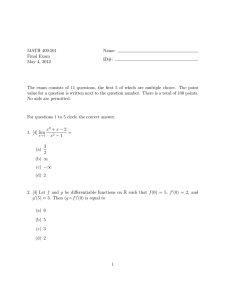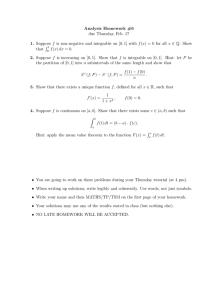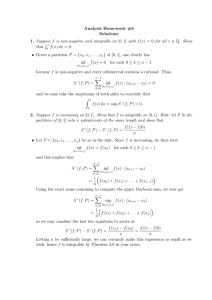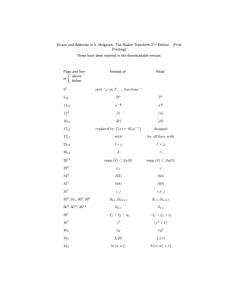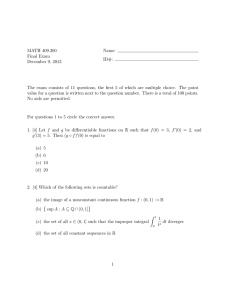Convergence of Banach valued stochastic processes of Pettis and McShane integrable functions ∗†
advertisement
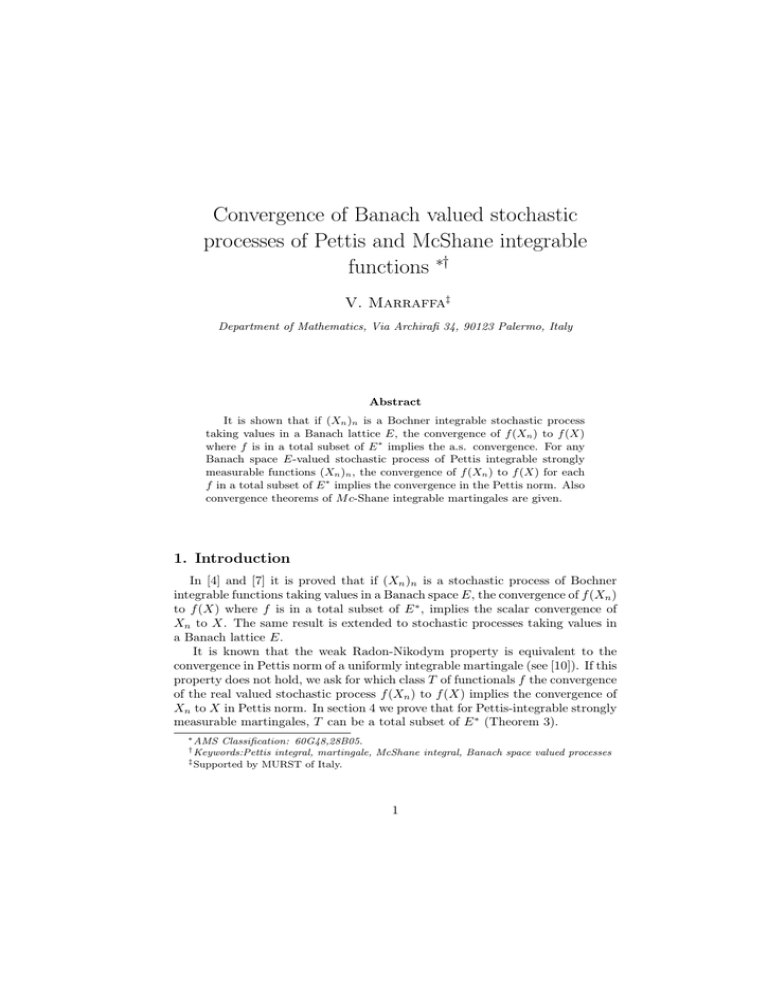
Convergence of Banach valued stochastic
processes of Pettis and McShane integrable
functions ∗†
V. Marraffa‡
Department of Mathematics, Via Archirafi 34, 90123 Palermo, Italy
Abstract
It is shown that if (Xn )n is a Bochner integrable stochastic process
taking values in a Banach lattice E, the convergence of f (Xn ) to f (X)
where f is in a total subset of E ∗ implies the a.s. convergence. For any
Banach space E-valued stochastic process of Pettis integrable strongly
measurable functions (Xn )n , the convergence of f (Xn ) to f (X) for each
f in a total subset of E ∗ implies the convergence in the Pettis norm. Also
convergence theorems of M c-Shane integrable martingales are given.
1. Introduction
In [4] and [7] it is proved that if (Xn )n is a stochastic process of Bochner
integrable functions taking values in a Banach space E, the convergence of f (Xn )
to f (X) where f is in a total subset of E ∗ , implies the scalar convergence of
Xn to X. The same result is extended to stochastic processes taking values in
a Banach lattice E.
It is known that the weak Radon-Nikodym property is equivalent to the
convergence in Pettis norm of a uniformly integrable martingale (see [10]). If this
property does not hold, we ask for which class T of functionals f the convergence
of the real valued stochastic process f (Xn ) to f (X) implies the convergence of
Xn to X in Pettis norm. In section 4 we prove that for Pettis-integrable strongly
measurable martingales, T can be a total subset of E ∗ (Theorem 3).
∗ AMS
Classification: 60G48,28B05.
integral, martingale, McShane integral, Banach space valued processes
‡ Supported by MURST of Italy.
† Keywords:Pettis
1
In the last section we shall deal with martingales of McShane integrable
functions and the analogous of Theorem 3 is proved (see Theorem 8).
2. Preliminaries
Let E be a Banach space with norm || · ||, B(E) its unit ball and E ∗ its dual.
A subset T of E ∗ is called a total set over E if f (x) = 0 for each f ∈ T implies
x = 0.
Throughout (Ω, F, P ) is a probability space and (Fn )n∈IN a family of sub-σalgebras of F such that Fm ⊂ Fn if m < n. Moreover, without loss of generality,
we will assume that F is the completion of σ(∪n Fn ).
Let F0 be a sub-σ-algebra of F, then a function X : Ω → E is called weakly F0
-measurable if the function f (X) is F0 -measurable for every f ∈ E ∗ . A weakly
F-measurable function is called weakly measurable. A function X : Ω → E is
said to be Pettis integrable if f (X) is Lebesgue integrable on Ω for each f ∈ E ∗
and there exists a set function ν : F → E such that
Z
f ν(A) =
fX
A
∗
R
for all f ∈ E and A ∈ F. In this case we write ν(A) = P A X and we call
ν(Ω) the Pettis integral of X over Ω and ν is the indefinite Pettis integral of X.
The space of all E-valued Pettis integrable functions is denoted by P(E). The
Pettis norm of a Pettis integrable functions is:
Z
|X|P = sup
|f (X)| : f ∈ B(E ∗ ) .
Ω
The pair (Xn , Fn ) is called a stochastic process of Pettis integrable functions if,
for each n ∈ IN , Xn : Ω → E is Pettis integrable, Xn is weakly Fn -measurable
and the Pettis conditional expectation E(Xn |Fm ) of Xn exists for all n ≥ m.
It should be noted that, in general, if X is only Pettis integrable, even it is
strongly measurable, there is no Pettis conditional expectation of X with respect
to a sub-σ-algebra of F. The stochastic process (Xn , Fn ) is called a martingale
if E(Xn |Fm ) = Xm for n ≥ m.
A martingale (Xn , Fn ) is
(i) convergent in P(E) if there exists a function X ∈ P(E) such that
lim |Xn − X|P = 0;
n→∞
R
(ii) variationally bounded if supn |νn |(Ω) < ∞ where νn (A) = P A Xn and
|νn | denotes the variation of νn ;
R
(iii) uniformly continuous if limP (A)→0 P A Xn = 0 uniformly with respect to
n;
(iv) uniformly integrable if it is variationally bounded and uniformly continuous.
2
3. Banach lattice valued stochastic processes
In this section we consider stochastic processes consisting of strongly measurable Bochner integrable random variables taking values in a Banach lattice
(see [5], Chapter VIII). For an element x ∈ E we denote by x+ the least upper
bound between x and 0. The Banach lattice E is said to have the order continuous norm or, briefly, to be order continuous, if for every downward directed
set {xα }α in E with ∧α xα = 0, then limα ||xα || = 0. The norm on a Banach
space has the Kadec-Klee property with respect to a set D ⊂ E ∗ if whenever
limn f (xn ) = f (x) for every f ∈ D and limn ||xn || = ||x||, then limn xn = x
strongly. If D = E ∗ we say that the norm has the Kadec-Klee property. It was
proved in [3] the following renorming Theorem for Banach lattices.
Theorem 1 A Banach lattice E is order continuous if and only if there is an
equivalent lattice norm on E with the Kadec-Klee property.
It is obvious that if E is separable, the equivalent norm has the Kadec-Klee
property with respect to a countable set of functionals.
A stopping time is a map τ : Ω → IN ∪ {∞} such that, for each n ∈ IN ,
{τ ≤ n} = {ω ∈ Ω : τ (ω) ≤ n} ∈ Fn . We denote by Γ be the collection of all
simple stopping times (i.e. taking finitely many values and not taking the value
∞), then Γ is a set filtering to the right. A stochastic process (Xn , Fn ) is called
a subpramart if for each ε > 0 there exists τ0 ∈ Γ such that for all τ and σ in Γ,
τ, σ ≥ τ0 then
P ({||(Xσ − E(Xτ |Fσ ))+ || > ε}) ≤ ε.
If (Xn , Fn ) is a positive supramart, then for each f ∈ (E ∗ )+ , where (E ∗ )+
denotes the nonnegative cone in E ∗ , (f (Xn ), Fn ) and (||Xn ||, Fn ) are real valued
positive subpramarts ([5], Lemma viii.1.12)
If E has the Radon-Nikodym property each L1 -bounded subpramart converges
strongly a.s.. Without assuming this property we ask which class of functionals
has the property that the scalar convergence of f (Xn ) to f (X) for each f in
the class implies the strong convergence. We are able to prove the following
theorem.
Theorem 2 ([8], Theorem 3.8) Let E be an order continuous Banach lattice,
which is weakly sequentially complete and let T be a total subset of E ∗ . Let
(Xn , Fn ) be a positive subpramart with an L1 -bounded subsequence and let X
be a strongly measurable random variable. Assume that, for each f ∈ T , f (Xn )
converges to f (X) a.s. (the null set depends on f ). Then Xn converges to X
strongly a.s..
Proof. Since (Xn ) and X are strongly measurable it is possible to assume that
E is separable. By a decomposition theorem ([5], Lemma viii.1.17) and the fact
that a subsequence of (Xn )n , still denoted by (Xn )n , is L1 -bounded we can also
assume that
Xnk = Ynk + Znk
3
where Ynk and Znk are Fnk -measurable, (Ynk )k is uniformly integrable and
limk Znk = 0, a.s.. For each f ∈ (E ∗ )+ , f (Xn )n is a real valued subpramart with
an L1 -bounded subsequence, then it converges a.s. to a real random variable
Xf . Also f (Ynk ) converges to Xf a.s. and in L1 . In particular for each f ∈ T ,
limk f (Ynk ) = f (X). So for A ∈ σ(∪n Fn )
Z
lim
f (Ynk )
k
A
R
exists in IR. Hence ( A Ynk )k is weakly Chauchy. Since the Banach lattice E is
weakly sequentially complete, let for every A ∈ σ(∪n Fn )
Z
µ(A) = w − lim
Ynk .
k
A
Then µ is a measure of bounded variation and it is absolutely continuous with
respect to P . For each f ∈ T we have
Z
Z
f (µ(A)) = lim
f (Ynk ) =
f (X).
k
A
A
Let An = {||X|| ≤ n}, then XIAn is Bochner integrable and
Z
Z
f (X) = f
X.
f (µ(An )) =
An
An
Since T is a total set it follows that
µ(An ) =
Z
X.
An
Moreover the uniform integrability of (Ynk )k implies that
Z
Z
||X|| = ||µ||(An ) ≤ sup
Ynk ,
k
An
(1)
Ω
and since X is strongly measurable, P (∪n (||X|| ≤ n)) = 1. Letting n → ∞ in
(1), we get that X is Bochner integrable and for each A ∈ σ(∪n Fn )
Z
µ(A) =
X.
A
It follows that
Z
f (X) = f (µ(A)) = lim
k
A
Z
A
f (Ynk ) =
Z
Xf ,
A
for each f ∈ (E ∗ )+ and A ∈ ∪n Fn . Hence f (X) = Xf a.s. and for each
f ∈ (E ∗ )+ , f (Xn ) converges to f (X) a.s.. Let ||| · ||| denote the Kadec-Klee norm
4
equivalent to || · ||, as in Theorem 1, and let D ∈ (E ∗ )+ be a countable norming subset. Applying ([5], Lemma viii.1.15) to the sequence {(f (Xn ), Fn ), n ∈
IN, f ∈ D} it follows that limn |||Xn ||| = |||X|||, a.s.. Now invoking again Theorem
1 we get the strong convergence of Xn to X and the assert follows.
2
Considering that if a Banach space E does not contain c0 , it is order continuous and weakly sequentially complete, the following corollary holds.
Corollary 1 Let E be a Banach lattice not containing c0 as an isomorphic
copy and let T be a total subset of E ∗ . Let (Xn , Fn ) be a positive subpramart
with an L1 -bounded subsequence and let X be a strongly measurable random
variable. Assume that, for each f ∈ T , f (Xn ) converges to f (X) a.s. (the null
set depends on f ). Then Xn converges to X strongly a.s..
4. Convergence of Pettis integrable stochastic processes
In this section we consider Pettis integrable stochastic processes.
Theorem 3 Let (Xn , Fn ) be an uniformly integrable martingale of Pettis integrable strongly measurable functions, X a weakly measurable function. Let T be
a total subset of X ∗ , and assume that f (Xn ) converges to f (X) a.s. for each
f ∈ T (the null set depends on f ). Then X ∈ P(E) and Xn converges to X in
the Pettis norm.
Proof. By Pettis measurability Theorem we can assume that E is separable,
then since T is closed and weak ∗ -dense, the assert follows from [9] Theorem 1.
2
Remark 1 Since in Theorem 3 we can suppose E separable, the weak measurability of X can be replaced by the measurability of the functions f (X) for all
f ∈ T (see [2]).
We will extend Theorem 3 to more general stochastic processes (Xn , Fn ).
Definition 1 A stochastic process
(Xn , Fn ) of Bochner integrable functions is
R
said to be L1 -bounded if supn Ω ||Xn || < ∞.
Definition 2 A stochastic process (Xn , Fn ) of strongly measurable functions is
said to be a game which becomes fairer with time (briefly a P -martingale), if
for each ε > 0
lim sup P (||E(Xm |Fn ) − Xn || > ε) = 0.
n m≥n
5
If for each ε > 0
lim sup P ( sup ||E(Xm |Fq ) − Xq || > ε) = 0
n m≥n
n≤q≤m
the sequence (Xn , Fn ) is called a mil.
Definition 3 A stochastic process (Xn , Fn ) of Pettis integrable functions is
σ-bounded if there exists an increasing sequence (Bn )n , Bn ∈ Fn , such that
limn P (Bn ) = 1 and the sequence (Xn ) restricted to each Bm , m = 1, 2, . . . , is
L1 -bounded.
For more details and the proofs of the following Theorems see [9].
Theorem 4 Let (Xn , Fn ) be a σ-bounded P -martingale of Pettis integrable
functions and X a weakly measurable function. Let T be a total subset of E ∗ ,
and assume that f (Xn ) converges to f (X) a.s. for each f ∈ T (the null set
depends on f ). Then Xn converges to X in probability (i.e. for every ε > 0 we
have limn→∞ P (|Xn − X| > ε) = 0).
Theorem 5 Let (Xn , Fn ) be a σ-bounded mil of Pettis integrable strongly measurable functions and X a weakly measurable function. Moreover let T be a total
subset of E ∗ , and assume that f (Xn ) converges to f (X) a.s. for each f ∈ T (the
null set depends on f ). Then Xn converges to X a.s. in the strong topology.
As we noted in Remark 1 the hypothesis of weak measurability of X in Theorems
4 and 5 can be substituted by the measurability of the functions f (X) for all
f ∈ T.
Assuming a weaker strong measurability condition on the martingale (Xn , Fn ),
in Theorem 3 we obtain:
Theorem 6 Let (Xn , Fn ) be an uniformly integrable martingale of Pettis integrable functions such that the indefinite integrals of all Xn have norm relatively
compact range and let X be a weakly measurable function. Assume that there
exists an increasing sequence of measurable sets (Bm )m , Bm ∈ Fm , such that
limm P (Bm ) = 1 and that the function Xn restricted to each Bm is strongly
measurable, n = 1, 2, . . .. Assume, moreover, that for each f ∈ T , where T is
a total set, f (Xn ) converges to f (X) a.s. (the null set depends on f ). Then
X ∈ P(E) and Xn converges to X in the Pettis norm.
Theorem 3 and Theorem 6 hold also for amarts, changing the proofs as in
[13] Theorem 2.
6
5. Martingale of McShane integrable functions
In this section we consider stochastic processes of McShane integrable functions.
Let (Ω, A, F, P ) be a probability space which is a quasi-Radon, outer regular
and compact probability space. A Mc-Shane partition of Ω is a set {(Si , ωi ), i =
1, . . . , p} where (Si )i is a disjoint family of measurable sets of finite measure,
P (Ω \ ∪pi=1 Si ) = 0 and ωi ∈ Ω for each i = 1, . . . , p. A gauge on Ω is a
function ∆ : Ω → A such that ω ∈ ∆(ω) for each ω ∈ Ω. A Mc-Shane partition
{(Si , ωi ), i = 1, . . . , p} is subordinate to a gauge ∆ if Si ⊂ ∆(ωi ) for i = 1, . . . , p.
A function f : Ω → E is McShane integrable (briefly M -integrable), with McShane integral z ∈ E if for each ε > 0 there exists a gauge ∆ : Ω → A, such
that
p
X
P (Si )f (ωi ) − z < ε
i=1
for each McShane partition {(Si , ωi ) : i = 1, . . . , p} subordinate
toR ∆.
It is known that if f : Ω → E is M -integrable, then νf (Ω) = (M ) A f : A ∈ F
is totally bounded (see [1], Theorem B and [6], Corollary 3E), hence it is norm
relatively compact. Denote by M (E) the set of all M -integrable functions endowed with the seminorm
Z
∗
|f (X)| : f ∈ B(E ) ,
|X|M = sup
Ω
which is equivalent to the seminorm ([11])
Z
sup M X : A ∈ F .
A
If G is a sub-σ-algebra of F, X is McShane integrable and Y is McShane integrable on (Ω, A, G, P ), then Y is called the McShane conditional expectation of
X with respect to G if
(i) Y is weakly G-measurable;
R
R
(ii) for every A ∈ G, M A Y = M A X.
The symbol Y = EM (X|G) will denote the McShane conditional expectation of
X with respect to G.
We say that (Xn , Fn ) is a stochastic process of M -integrable functions, if for
each n ∈ IN , Xn is M -integrable, Xn is weakly measurable with respect to
Fn and the McShane conditional expectation EM (Xn |Fm ) of Xn exists for all
n ≥ m. Also we observe that the conditional expectation of a M -integrable
function does not always exist, indeed the same is true for strongly measurable
Pettis integrable functions and a strongly measurable Pettis integrable function
is McShane integrable.
7
As in case of a stochastic process of Pettis integrable functions, we say that
(Xn , Fn ) is a martingale if Xn is a M -integrable function for each n, and if for
all n ≥ m EM (Xn |Fm ) = Xm or equivalently for all A ∈ Fm
Z
Z
M Xm = M Xn .
A
A
If X is M -integrable and EM (X|Fn ) exists for all n, then Xn = EM (X|Fn ) is
called a closed
a M -integrable function is Pettis integrable and
Rmartingale. Since
νf (Ω) = (M ) A f : A ∈ F is norm relatively compact, there exists a sequence
of simple functions fn : Ω → E, converging to f in | · |M , i.e. lim |fn − f |M = 0.
The following proposition is an extension of Lemma 1.4 of [12] to a martingale
of McShane integrable functions. The proof follows with suitable changes.
Proposition 1 Let (Xn , Fn ) be a martingale of M -integrable functions. Then
the following are equivalent:
(i) there exists a M -integrable function X such that Xn is | · |M convergent
to X;
(ii) there exists a M -integrable function X such that EM (X|Fn ) = Xn for
each n ∈ IN ;
(iii) there exists a M -integrable function X such that for each A ∈ ∪n Fn
Z
Z
lim M Xn = M X.
n
A
A
The condition (ii) ⇒ (i) in the previous Proposition says that a closed martingale is | · |M convergent. We have the following:
Proposition 2 Let (Xn , Fn ) be a martingale of M
R -integrable functions. Then,
for all A ∈ ∪n Fn , the set function µ(A) = limn M A Xn is absolutely continuous
and has norm relatively compact range if and only if the martingale (Xn , Fn ) is
| · |M Chauchy.
Proof. First we prove the necessary part.
Since µ has norm relatively compact range, by Hoffman-Jorgensen
Pk Theorem for
each ε > 0 there exists a function Hε : Ω → E such that Hε = i=1 xi IAi , with
Ai ∈ ∪n Fn and xi ∈ E, so that
Z
sup µ(A) −
Hε : A ∈ ∪n Fn < ε.
A
Take ε > 0 and let H = Hε/4 , there exists m0 for which Ai ∈ Fm0 , for i =
R
R
1, . . . , k. Since µ(A) = limn M A Xn there is m0 such that µ(A) − M A Xn <
ε
4 for n > m0 . Let n, m ≥ m0 .
8
We have
R
sup M A (Xn − Xm ) : A ∈ ∪n Fn
R
R
≤ sup M A (Xn − H) : A ∈ ∪n Fn + sup M A (H − Xm ) : A ∈ ∪n Fn
R
R
≤ sup M A Xn − µ(A) : A ∈ ∪n Fn + sup µ(A) − M A H : A ∈ ∪n Fn
+
R
R
sup M A Xm − µ(A) : A ∈ ∪n Fn + sup µ(A) − M A H : A ∈ ∪n Fn
<
ε
4
+
ε
4
+
ε
4
+
ε
4
= ε.
Then |Xn − Xm |M < ε for n, m ≥ m0 .
Conversely choose
R ε > 0 and find m0 such that if n, m ≥ m0 then |Xn −Xm |M <
ε. If µn (A) = M A Xn for A ∈ ∪Fn then
||µn (A) − µm (A)||M ≤ |Xn − Xm |M < ε.
So the sequence of measures µn is Chauchy, therefore limn µn (A) = µ(A) exists.
The functions Xn are M -integrable, then µn has a norm relatively compact
range and since the convergence is uniform in A ∈ ∪n Fn , it follows that µ is
absolutely continuous and has a norm relatively compact range.
2
Proposition 1 and Proposition 2 hold also for M -integrable martingales indexed
by a directed set.
We will prove now two convergence theorems for a M -integrable martingale.
Theorem 7 Let (Xn , Fn ) be an uniformly integrable martingale of M -integrable
functions and suppose that there exists a weakly measurable function X : Ω → E
such that f (Xn ) converges to f (X) a.s.. Then Xn is | · |M convergent to X.
Proof. Since (Xn )n is uniformly integrable the set function ν : ∪n Fn → E
defined as
Z
ν(A) = lim M Xn
n
A
is an absolutely continuous measure of bounded variation and it can be extended
to the whole F to an absolutely continuous measure of bounded variation. Moreover for each ω ∈
/ N with P (N ) = 0, f (Xn (ω)) converges to f (X(ω)) for each
f ∈ E ∗ . Hence
it
follows from [6] Theorem 4A that X is M -integrable and
R
ν(Ω) = M Ω X. Then for each A ∈ ∪n Fn
Z
Z
lim M Xn = M X
n
A
A
and the assert follows from Proposition 1.
9
2
Definition 4 A function X : Ω → E is called weakly asymptotically measurable with respect to an increasing family (Fn )n of sub-σ-algebras of F if there
exists an integer N such that for all n > N and for all f ∈ E ∗ f (X) is Fn measurable.
Theorem 8 Let (Xn , Fn ) be an uniformly integrable martingale of M -integrable
functions and let T be a weak ∗ -sequentially dense subset of E ∗ . Assume that
there exists a weakly measurable function X : Ω → E such that X is weakly
asymptotically measurable with respect to (Fn ) and such that, for each f ∈ T ,
f (Xn ) converges to f (X) a.s. (the null set depends on f ). Then Xn is | · |M
convergent to X.
Proof. Since each McShane integrable function is Pettis integrable it follows
by [9] Theorem 1 that X is Pettis integrable, (Xn ) converges to X in the Pettis
norm and
Z
Z
µ(A) = lim M Xn = P
X
n
A
A
for all A ∈ ∪n Fn . We want to prove that X is M -integrable. Since X is
weakly asymptotically measurable there exists N ∈ IN such that X is weakly
FN -measurable, then
E(X|FN ) = X
(2)
and also
E(X|FN ) = XN .
(3)
Then (2) and (3) implies that X = XN a.s. and X is M -integrable. Therefore
the assert follows from Proposition 1.
2
References
[1] Zvi Artstein, Lyapounov convexity theorem and Riemann-type integrals,
Indiana Univ. Math. J., Vol.25, N.8, 717-724, (1976).
[2] A. Bozorgnia and M. Bhaskara Rao, Measurability and convergence theorems for random elements in Banach spaces in terms of total subset of
linear functionals, Bulletin of the Institute of Math. Academia Sinica, Vol.
14,N. 4, 383-416,(1986).
[3] W. J. Davis, N. Ghoussoub and J. Lindenstrauss, A lattice renorming theorem and applications to vector-valued processes, Trans. Amer. Math. Soc.,
Vol. 263, N. 2, 531-540, (1981).
[4] W. J. Davis, N. Ghoussoub, W. B. Johnson, S. Kwapien and B. Maurey, Weak convergence of vector valued martingales, Probability in Banach
spaces, Vol. 6, 41-50, (1990).
10
[5] L. Egghe, Stopping Time Techniques for Analysts and Probabilist, London
Mathematical Society, Lecture Notes, vol. 100, Cambridge University Press,
(1984), Cambridge.
[6] D. H. Fremlin, The generalized McShane integral, Illinois J. Math., Vol.
39, N.1, 39-67, (1995).
[7] V. Marraffa, On almost sure convergence of amarts and martingales without
the Radon-Nikodym property, J. of Theoretical Prob., Vol.1, N.3, 255-261,
(1988).
[8] V. Marraffa, Convergenza di processi stocastici senza la proprietà di RadonNikodym, Ph.D. Univ. of Palermo, (1988).
[9] V. Marraffa, Stochastic processes of vector valued Pettis and McShane
integrable functions, preprint.
[10] K. Musial, Martingale of Pettis integrable functions, Lecture Notes in
Math., Springer-Verlag, Vol. 794, 324-339, (1980).
[11] C. Swartz, Beppo Levi’s theorem for vector valued McShane integral and
applications, Bull. Belg. Math. Soc., Vol. 4, N. 5, 589-599, (1997).
[12] J.J. Uhl, Jr., Martingales of strongly measurable Pettis integrable functions, Trans. of Amerrican Math. Soc., Vol. 167, 369-378, (1972).
[13] J.J. Uhl, Jr., Pettis mean convergence of vector-valued asymptotic martingales, Z. Wahr. verw. Geb., Vol. 37, 291-295, (1977).
V. Marraffa
Department of Mathematics, University of Palermo,
Via Archirafi, 34, 90123 Palermo (Italy)
marraffa@dipmat.math.unipa.it
11


